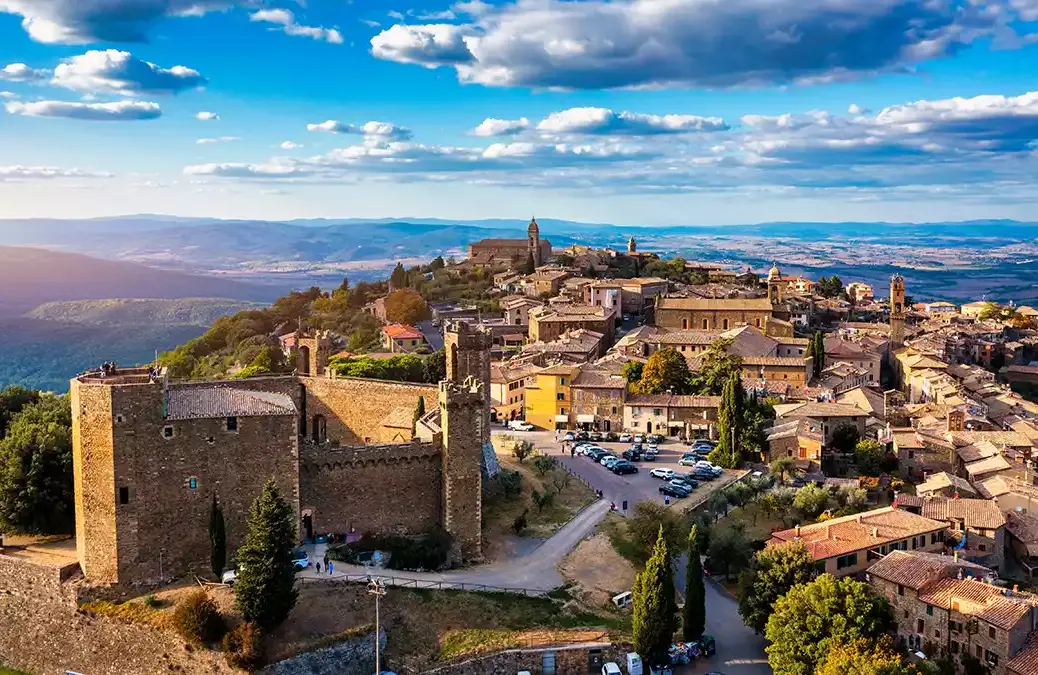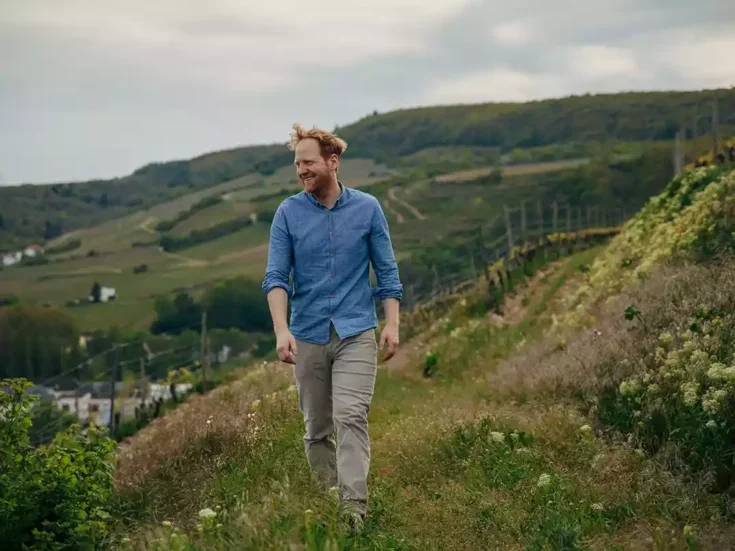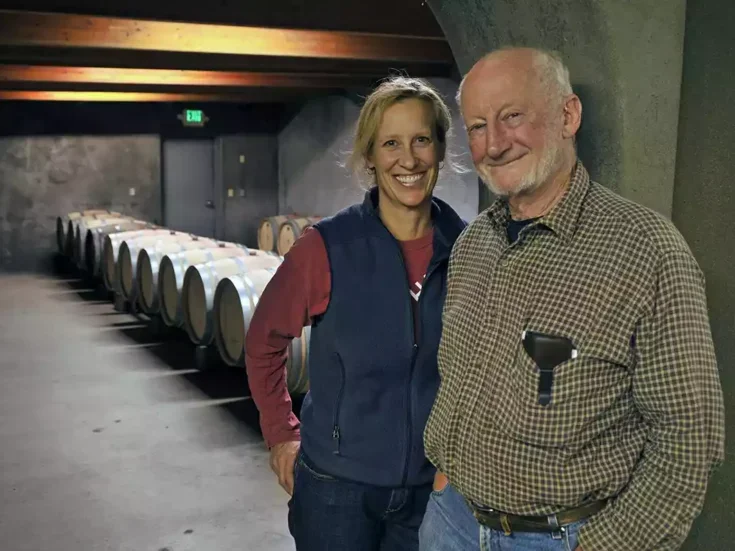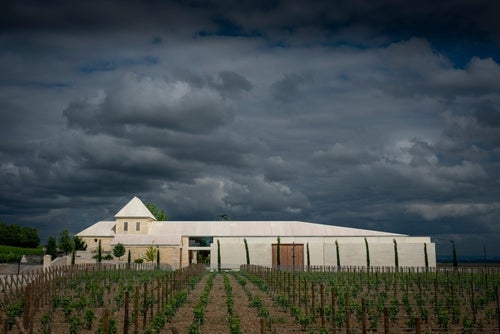
Andrew Jefford is joined by Bruno Besa and Michael Palij MW for a hugely successful and high-scoring tasting of 2019 Brunello di Monalcino, a vintage that came as a very welcome relief in southern Tuscany after the heat-scorched 2017 and the difficult 2018, and which is perhaps even better than the widely celebrated 2016.
This is an extract from an article first published in WFW84. For full tasting notes and scores for all 45 wines tasted by the panel, subscribe to The World of Fine Wine.
It was clear, from the first flight: The wines were darker than usual. A lowered gaze, perhaps; a sense of brooding intent. Color alone is an inadequate guide to quality, of course, but it’s not insignificant either. There was clearly more polyphenolic matter than usual in the 2019 Brunello offerings, and it had clung to the wines through their long aging process (at least two years in wood and four months in bottle, with the wines coming to market in the fifth year after harvest).
Then we began to sniff and to taste. And to smile, delightedly—and soon the keyboards were clattering, as we tripped, stumbled, and struggled to verbalize our enthusiasm for this challenging but immensely rewarding tasting. “A truly memorable day at the office,” concluded Bruno Besa after tasting “this remarkable flight of outstanding wines.” Michael Palij MW found the wines “looking very smart indeed […]. Almost without exception, these are wines to recommend and to cellar.” Bruno loved “their intrinsic complexity, stylistic uniformity, weightlessness, and transparent character”; while for Michael it was discreet oak, ripe and spicy fruit, complexity, and “a freshness and vivacity that rounded out a most appealing picture.”
For my part, 2019 struck me as certainly the best Brunello di Montalcino vintage range I have tasted for The World of Fine Wine: exciting, dense, articulate wines of striking consistency (denser and more consistent, by the way, than Barolo 2019). This came as a great reassurance after Lucifer’s fearsome visit to Montalcino in 2017 and the sometimes gawky struggles of 2018. No, it is not yet too hot to make magnificent and enduring wines here in southern Tuscany.
Before writing this introduction, I looked back to our tasting of 2016 Brunello—the only other recent vintage of similarly acclaimed quality. We showed plenty of enthusiasm for 2016, too, of course,but the aggregate scores for 2019 were clearly higher. To take just two indicators, five wines from 2019 exceeded the highest 2016 average score of 95; while 16 wines averaged below 90 in 2016, compared to only three wines in 2019. When you consider that 2019 was also a generous vintage in Montalcino (98,407hl—by some margin the largest harvest between 2019 and 2023), the producers have much to smile about as they bring their wines to market.
A generous and healthy crop
It was a serene growing season. After a cool but relatively mild January and February, March 2019 was wet and warm and budburst came early, at the end of March and beginning of April. April remained wet, to the extent that there was some early-season disease pressure, though this month was cooler than March had been in relation to long-term averages. The north wind began to blow in May, though: a cure for the vines. Flowering was extended though not compromised.
June and July were hot and dry, upping the tempo once again; and a two-day period of heavy rains at the end of July brought a welcome 2.8in (70mm) of water. Early August was again intensely hot, with temperatures of 98.6–100.4°F (37–38°C); véraison came in mid-August. By September, the heat had eased, though the month remained sunny and largely dry apart from two well-separated rain episodes. Harvesting began in the southern part of the Montalcino zone on September 10, but no one had to hurry. Cool nights from mid-September onward meant a slow, courtly end to the season, and higher-altitude vineyards were still being picked in mid-October.
It was, overall, a slightly warmer vintage than 2016; and since the generous crop had been evident from flowering onward, some producers green-harvested. Everyone was delighted with the glamorous good looks of the harvested bunches and berries, and little sorting was required. Many growers mentioned a “crunchy” quality to the fruit—firm flesh and ripe seeds, but fresh balancing acidity, too. The healthy skins delivered ample but accessible tannins.
A great leveler in two senses
This will surely be one of the highest-scoring tastings of table wines ever to appear in The World of Fine Wine. Not only did we find no fewer than 12 wines in the 97–100-point range (“Great wine of spellbinding beauty and resonance, leaving the drinker with a sense of wonder”), but we also found an astonishing 54 wines in the 93–96-point range (“Outstanding wine of great beauty and articulacy”). Bruno Besa was the most enthusiastic taster, with six wines at 97+ (I found four and Michael Palij MW two) and 25 wines at 93+ (compared to Michael’s 18 and my 11). In most cases, our enthusiasms overlapped, differing only in degree. This underlines the extraordinary consistency of the vintage. 2019 is a great leveler, in that there are many ways in which to embody excellence this year; use our descriptions to find wines to suit your own tastes. It also means that there are bargains to be had, with some new names appearing in our top-scoring brackets. No fewer than four of the wines in our 2019 top 11, for example (with an aggregate score of 93.7 or higher) scored just 89 in our tasting of 2016 Brunello (Uccielliera, the “winning” wine, as well as Caparzo La Casa, Poggio Landi, and La Gerla).
Our tasting suggests, too, that the vintage could also be described as a leveler in terms of geographical origin within the DOCG zone. In fiercely hot vintages, those in the northern part or with northern-facing slopes are thought to be best placed. Not so in 2019. Of our 11 top-scoring wines, three came from the north of the zone and three from the southwest. There were two from the northeast, one from the southeast, one from the west, and one from the center close to Montalcino itself: almost perfectly even geographical distribution within the DOCG.
The top five: The best of 2019 Brunello di Montalcino
Uccelliera Brunello di Montalcino (15% ABV) | 97
Bruno Beta | Garnet to tawny. On the nose: sweet tobacco, cedarwood, fine leather, super-
refined, complex, small red fruits, and dried herbs. Medium to full body, fine tannins, layered fruit, red berries, and a sea-salt finish. A superb Sangiovese. 2028–35. | 96
Andrew Jefford | Translucent black-red; just a touch lighter than the majority of its peers. Sweet, warm, lifted, commanding: super aromas here. Extraordinary grace, charm, and refinement—the sort of thing that only Italy is capable of achieving in a “young,” freshly released wine, and quite beyond France. Warm fruits, the glow of late summer, the last breath of the fields at dusk, the night chill creeping through the forest… Somehow it is all sketched out here. Bravo. On the palate, too, this is a magnificent wine of remarkable natural concentration and force, yet at the same time seamless, complete, already harmonious, and ready for the face-off against the years. Wherever you look for detail, you will find it here. The fruits (currants, cherries, plums—all here but “beyond,” modulated into a vinous refinement); the spices dug from the earth; the peeling, calving, tender tannins; the wrap of aroma in the soft fruit and in those peeling, calving tannins—you just have to marvel. A very fine wine by any measure. 2026–43. | 98
Michael Palin MW | Attractive and diffuse nose, showing black cherry, black plum, incense, licorice, blackberry, real cola, cinnamon, and oregano. The palate really does not disappoint, with ripe tannins, high alcohol, and moderate acidity. Although this will not develop further, it is currently a delicious glass of user-friendly Brunello that showcases the best aspects of this DOCG. 2026–30. | 96
Capanna Brunello di Montalcino (14.5% ABV) | 96
BB | Ruby to pink. Restrained, composed, youthful, and inviting nose of cherries, raspberries, and fresh-cut herbs. Super-refined palate, super-fine tannins; weightless and complex, with layered, pristine red fruit and a long, mineral finish. A class act. 2030–40. | 97
AJ | Dark, clear black-red. The fruits are more forthright here than for most: a trumpet blast of currant and plum (though being Brunello, the trumpet blast is finely tuned and modulated). Amply sweet and yet, typically for 2019, the sweetness is never cloying or overdrawn, and there’s a resolving freshness, too, which must come from healthy berries picked at the cusp of ripeness. Vivid, fresh, concentrated, allusive, energetic, arresting: a super wine here, one that powers through the mouth scattering fruited splendor behind it. It does need a little longer to settle down, but this bodes very well for the future. A fine site, for sure, and it has all come together here in 2019. 2026–38. | 94
MP | Gorgeous nose, with notes of cranberry, red cherry, wild strawberry, tomato leaf, cinnamon, oregano, and wild rose. The palate is no less intriguing, with the red and black fruit playing off notes of incense, tobacco, white pepper, and licorice. The tannins are part wood, part grape, and balanced by the ripe fruit and warming alcohol. The structure and the fruit drive a long finish that shows poise and the balance necessary to age. A tour de force. 2028–37. | 98
Collemattoni Brunello di Montalcino (15% ABV) | 96
BB | Deep garnet to pink. Deep, earthy, smoky, nose, with black cherries, forest floor, black truffles, dried herbs, and dried flowers (especially violets). Sweet, black-fruit palate, with super-fine tannins, layered black fruit, rich, long, and spicy. A superb wine of considerable body and extraction, yet with classic Sangiovese refinement. 2030–45. | 99
AJ | Dark, brooding black-red. Fine, dense, meaty, amply served aromas, suggesting a big, generous wine to come. Beautifully composed fruits here, glowing and venting in the glass. Super concentration and drama here. One of the most dramatic wines we have tasted today, this is a depth-charge beauty, with splendidly resonant fruits, rippling, soft tannins, almost insistent (though accommodated) acids; a mouth-drench that will leave no drinker unmoved. It is big and masterful, and you may prefer something more proportionate and “classical,” but as a cry of joy from its vineyard and its place on Earth, this is hard to overlook. I’m grateful to have had the chance to taste it. 2026–43. | 98
MP | Obvious nose, with muddled aromas of stewed fruit, raisin, cooked blackberry and autumn spices. The generous nose continues to the palate, where there is very ripe, baked fruit allied to cinnamon, vanilla, and nutmeg. This is a full-bodied, generous Brunello, with plenty of stuffing and plenty of oak to satisfy those looking for a come-hither Montalcino. 2025–29. | 92
Tenuta Luce Brunello di Montalcino (15% ABV) | 96
BB | Garnet to pink. Intense, clean, floral, elegant, red- and black-fruit nose, with fresh herbs, cranberries, red cherries, sea salt, and rosemary. Balanced, balsamic, clean, fruit-driven, lively palate, with huge yet fine tannins and a long, uplifting finish. 2030–38. | 96
AJ | Dark, dense black-red, though still translucent. Warm, generous, articulate, well-rounded: less aromatic detail than many, but everything that is there is just what you want to find: profound fruit, root spice, woodland lift. Concentrated and dramatic, with more of an emphasis on juicy acidity than structuring tannins here. Huge energy coursing through this wine, and ample aromatic lift from both palate and aromas. It is allusive, but somehow it is the inner drive and energy of the wine that absorbs the drinker’s attention. Very fine and still super-young; energy of this sort will take some years to settle and focus. Yet another riveting Brunello from 2019. 2026–38. | 96
MP | Refreshingly discreet nose, with subtle notes reminiscent of cherry, plum, and currant. There are also hints of licorice, spice, cinnamon, and cedar. The palate scoops all of these up with an addictive combination of fruit, soft tannins, and judicious acidity. The finish is correspondingly long, with layers of red and black fruit driven by the structural components. This is a great example of Brunello with both power and scale. Delicious. 2027–33. | 96
Talenti Brunello di Montalcino Piero (15% ABV) | 96
BB | Garnet to pink. Clean, elegant, youthful, and still a touch closed, with red cherries, peaches, minerals, and fresh and dried herbs on the nose. Poised, elegant, and weightless, with layered, red and black fruits, and a super-long, clean finish. Another beautifully crafted Sangiovese for medium- to long-term aging. 2030–40. | 98
AJ | Bright, translucent black-red. Refined and elegant aromatically, though without the bass aromatic charge of the best of its peers. A delicate intricacy here: teasing soft fruits and woodland finesse. Graceful, fresh, light, tender, and delicate; finely detailed withal. A wonderful, pure wind coursing through this wine, with eddies of lifted fruit flavor peeling off it. Shapely, sculpted, vivacious. The structure and articulation is coming from acidity much more than tannins here, but that matters not a whit; maybe we’re in the north, or north-
facing. This is Brunello di Montalcino in its most bourguignon guise. Irresistible lift, charm, and command. 2025–38. | 94
MP | Richly aromatic, with ripe notes of black cherry, plum, blackberry, hawthorn, and cooked plum, together with wood-derived notes of clove, cocoa, dark chocolate, and cedar. In the mouth, this has layers of flavor, with supporting tannins, vibrant acidity, and tremendous concentration of fruit. Part of a truly exciting lineup, this shows a roundness and polish that’s hard to deny. A great summary of Brunello, albeit for relatively early consumption. 2025–29. | 96






